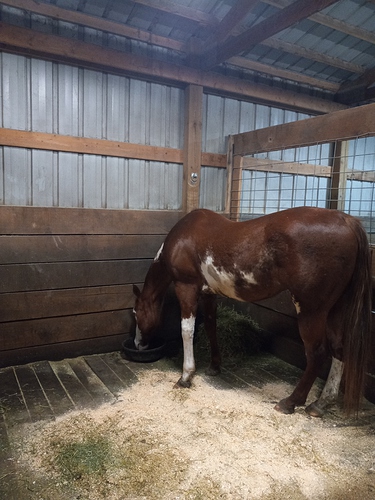Yes, sawdust right onto the wooden planks. No, never had any problem with forks catching on cracks… boards fit pretty tight. We did these stalls when we moved here and built accommodations. Local private saw mill right close by, ordered the planks from them.
When I was a kid, my Dad built the first barn for my Mom’s equine habit. That would have been in the mid 1950s. He put wooden floors into the stalls. repurposed oak boards that he got somewhere for nothing, since they didn’t have a lot of cash. We sold that farm in 1987, and some of our friends who boarded with us took those oak boards out of that barn, and put them in their own barn which they built on the hobby farm they bought and built. As far as I know, those boards are STILL in that barn. The farm we moved to, we built barns and put in compacted sand, with rubber mats. It was OK, but sometimes there was wear on the mats, and sometimes the edges came up. We sold that farm in 2008, and moved and built this farm. We are semi remote, and don’t use the stalls here much. There are only two stalls, in one end of the indoor arena. I used them when I had the stallion, he was old, and had (obviously) to be kept separate from the rest of the herd. So he and a friend would overnight in those stalls, and go out for the day in the snow. So I used them a bit until he died, and I used them with some overwintering race boarders who wanted early spring time light exercise in the arena. So they haven’t had as much use as that old barn did. But they are nice, not expensive, and work well. I used one last year for early backing breaking greenies, racetrack style. Traction with sawdust on top of boards was fine for walking around in there on greenies. There was no drama.
If you put wood floors in a run in, you would have to support the boards all the way around the outer edge, to make sure that they don’t move or shift. Without sawdust bedding on top of them, they may become slippery with wear, especially if someone wants to torque out of the run in shed at full speed. Our stalls in our FIRST barn, above, were open 24/7 to paddocks, and they could be a bit slippery when a quick exit was attempted.
Wood floors in barns are very “old school”, usually used in tie stalls 100+ years ago. But they still work the same, if they are easier and cheaper than other options.
If you want to put them in, gravel underneath them, and the treated 4 X 4s set into that gravel to make sure you get a level bearing surface. Then just lay the boards on top of those, fit tight together. You don’t have to nail the boards down, they stay in place. IF one ever breaks, easier to pry one out and replace it if not nailed down. I’ve never seen one break and need replacing.




